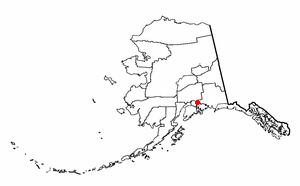Whittier, Alaska
|
|
Whittier is a town located in the Valdez-Cordova Census Area of Alaska. As of the 2000 census, the population of the town is 182.
| Contents |
Geography
Whittier is located at 60°46'27" North, 148°40'40" West (60.774174, -148.677649)Template:GR, near the Anton Anderson Memorial Tunnel.
Whittier is on the northeast shore of the Kenai Peninsula, at the head of Passage Canal, on the west side of Prince William Sound. Whittier is 120 km (75 miles) southeast of Anchorage.
According to the United States Census Bureau, the city has a total area of 51.0 km² (19.7 mi²). 32.5 km² (12.5 mi²) of it is land and 18.5 km² (7.2 mi²) of it is water. The total area is 36.36% water.
Demographics
As of the censusTemplate:GR of 2000, there are 182 people, 86 households, and 46 families residing in the city. The population density is 5.6/km² (14.5/mi²). There are 213 housing units at an average density of 6.6/km² (17.0/mi²). The racial makeup of the city is 79.12% White, 7.14% Asian, 5.49% Native American, and 8.24% from two or more races. Two people (1.10% of the population) are Hispanic or Latino of any race. There are no African Americans, Pacific Islanders, or people from other races.
There are 86 households out of which 29.1% have children under the age of 18 living with them, 41.9% are married couples living together, 4.7% have a female householder with no husband present, and 46.5% are non-families. 39.5% of all households are made up of individuals and 7.0% have someone living alone who is 65 years of age or older. The average household size is 2.12 and the average family size is 2.80.
In the city the population is spread out with 22.0% under the age of 18, 2.7% from 18 to 24, 36.8% from 25 to 44, 31.9% from 45 to 64, and 6.6% who are 65 years of age or older. The median age is 39 years. For every 100 females there are 111.6 males. For every ten females age 18 and over, there are 12.9 males.
The median income for a household in the city is $47,500, and the median income for a family is $51,875. Males have a median income of $53,500 versus $26,875 for females. The per capita income for the city is $25,700. 7.1% of the population and 4.1% of families are below the poverty line. Out of the total population, 14.6% of those under the age of 18 and 0.0% of those 65 and older are living below the poverty line.
History
The Whittier Glacier near Whittier was named for the American poet John Greenleaf Whittier in 1915.
During World War II the United States Army constructed a port and railroad terminus near the glacier and named the port Whittier. The spur of the Alaska Railroad to Whittier was completed in 1943 and the port became the entrance for United States soldiers into Alaska. The large The port remained an active army facility until 1960.
The two huge buildings that dominate Whittier were built after World War II. The Hodge Building (now Begich Towers) was built for housing soldiers and the Buckner Building, completed in 1953, was called the "city under one roof". It was once the largest building in Alaska. The port remained an active Army facility until 1960.
Whittier was incorporated in 1969. The Begich Building is now a condominium, and houses nearly all of Whittier's residents.
Whittier is a popular port of call for cruise ships, as it has connections to Anchorage and the interior of Alaska by both highway and rail. Whittier is also popular with tourists and sport fishermen.
External link
- City website (http://www.ci.whittier.ak.us/)

